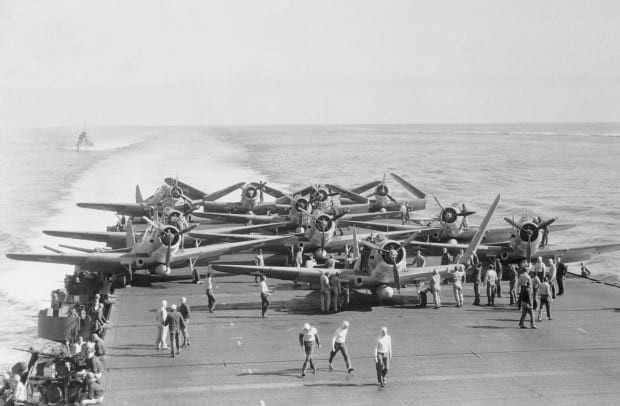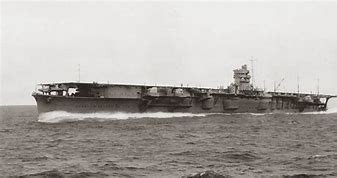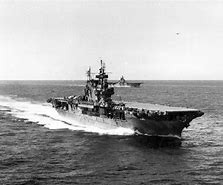After the Doolittle raid on April 18, 1942, it was necessary for the Japanese to take action. Japan was committed to forcing the United States into a peace agreement under Japanese conditions as soon as possible. The immense industrial power of the United States was well known and feared by the Japanese. The longer the conflict would last, the smaller the chances of the Japanese once U.S. industry was on steam.
The Japanese’s plan to establish their hold on part of the Pacific Ocean consisted of two parts. A mock attack on the Aleutians to distract the Americans and an attack on the important American island of Midway. However, the Americans had now deciphered the communication code of the Japanese navy and the Japanese movements and attacks were foreseen and expected. The diversionary maneuver at the Aleutians failed because of that, and the Americans were preparing for a fight for the island of Midway, which was equipped with a large U.S. Air Force base.
The Japanese’s Plan
The Japanese had a large fleet of warships, sixteen submarines, four aircraft carriers, eight battleships and various smaller and transport and supply ships. The fleet was under the command of Admiral Isoruku Yamamoto and was mainly looking for the American aircraft carriers that had escaped the attack on Pearl Harbor. The important four Japanese aircraft carriers together accounted for the Kaga, the Akagi, the Soryu and the Hiryu. The call sign of the squadron aircraft carriers was Kido Butai and was under the command of Admiral Chuichi Nagumo. The goal was to bomb the U.S. military installations on Midway and find and destroy the U.S. aircraft carriers. The accompanying ships had 5000 Marines on board who had to be put ashore for an invasion on Midway.
The Americans
The Americans also had four aircraft carriers, the Enterprise, the Hornet, Lexington and the Yorktown and a number of lighter battleships, under the supreme command of Admiral Nimitz. The operational leadership was in the hands of Admiral Fletcher, commander of the Yorktown. On Midway, the Americans had 115 warplanes and bombers and had the first generation of radars on both Midway and the ships, which reached up to 100 km. The Japanese did not have radar yet.
The Battle of the Coral Sea, 4 May – 8 May 1942
A battle that preceded the battle of Midway was the battle of the Coral Sea. During the first months of 1942, the Japanese armed forces had occupied British Malaysia, the Dutch East Indies, Singapore, Wake Island, New Britain, the Gilbert Islands, Guam, the Philippines and the northern part of New Guinea. The next priority was now to protect the conquered territories, by occupying a ring important islands in the Pacific. All this to isolate Australia and New Zealand and serve as a stepping stone for an invasion of Australia. As part of these plans, Vice Admiral Shigeyoshi Inoue, commander of the 4th Fleet, suggested an amphibious landing to be carried out on Port Moresby, the capital of Australian New Guinea. From there, aircraft could reach Australia. The general staff of the Japanese Navy agreed to the plan and promised all cooperation. In mid-April 1942, the plan was ready under the code name MO. On May 10, the Australian stronghold should have been taken. Yamamoto was preparing for the invasion of Midway, plan codename MI. Despite the fact that he considered plan MI of much greater importance than plan MO, Yamamoto authorised the aircraft carriers Zuikaku, Shokaku and Shoho, together with the accompanying cruisers, destroyers and a tanker, to temporarily assign to Inoue (commanders Takeo Taragi and Aritomo Goto), with the risk that this would be at the expense of plan MI.
The battle in the Coral Sea took place from 4 to 9 May 1942 and was the first naval battle fought by only aircraft carriers, which did not see each other during the battle, had never been shown before. Both the Americans and the Japanese claimed victory after the battle. The Japanese had indeed knocked out the Lexington, severely damaged the Yorktown and sunk a tanker and a destroyer. The Japanese had lost only a small aircraft carrier, a destroyer and three minesweepers. The Japanese rightly claimed a tactical victory, the Americans a strategic one, because the Japanese should have postponed the invasion of Port Moresby and isolation from Australia. After the Doolittle Raid, this was the second moral boost for the Americans.
Due to the inexperience with fighting between aircraft carriers, major mistakes had been made on both sides. The Americans improved the attack tactics, coordination and lines of communication between the aircraft carriers and the fighter jets. Furthermore, improvements were made to the anti-aircraft defence and damage-restricting procedures were tightened. In addition, the jet fuel tanks were better protected. The Japanese didn’t learn much. Yamamoto was in such a hurry with the Midway invasion that he did not check whether the Lexington and Yorktown were really definitively disabled. He did not take into account the Yorktown at the Battle of Midway, which had been patched up again on time due to a huge effort by the yard staff at Pearl Harbor.
The Battle of Midway, 4 June – 7 June 1942
The four remaining aircraft carriers of the Japanese were the Kaga, Akagi, Soryu and the Hiryu. Early in the morning American time, the battle of Midway began. Nagumo attacked at dawn. He had half of his planes take off to bomb Midway. The bombing lasted 20 minutes and caused significant damage. The attack was expected and all U.S. aircraft had taken off from Midway and thus escaped the attack. The radar and reconnaissance flights of the PBY Catalinas had done their job just fine. The Japanese lost 30 planes through defense guns, the Americans 15 aged Brewster Buffalo’s.
The attack of the Americans

The three remaining aircraft carriers were the Enterprise, Hornet and the nearly-provisoryly repaired Yorktown. A U.S. reconnaissance aircraft, meanwhile, found two of the four Japanese aircraft carriers and reported the site. The Japanese’s reconnaissance flights were flawed and missed the U.S. aircraft carriers that were much closer to the Japanese fleet than thought. Because of the fact that he could not find the American fleet, Nagumo had half of his aircraft switched armaments and replaced the torpedoes with land bombs to bomb Midway again. This decision would be crucial later in the fight. Around the same time, 151 aircraft rose from the U.S. aircraft carriers and set course for the Japanese ships. The first-up planes could not wait for the rest and therefore the American attack was carried out by various groups. From Midway also departed American bombers and attacked scattered. Most of the attacks on the Hiryu ended in failure with loss of many aircraft and caused little damage.
By chance, a lost American squadron dive bombers found the cruiser Arashi and by following those they arrived at the Kaga, Akagi and Soryu. The American fleet had since been found by the Japanese and they were about to launch an attack on the American aircraft carriers. The fighter planes were already on their way to the Americans, but the arming of the dive bombers had to be changed to torpedoes again and the decks of the Japanese ships were full of armed aircraft, while the ammunition of the cancelled attack on Midway was still on the deck. The American dive bombers with a very experienced crew had free play and the Kaga, Akagi and Soryu got some bomb hits that caused a chain reaction to exploding aircraft, ammunition and fuel. First sank the Soryu, then the Kaga. The Akagi still tried to escape to Japan, but eventually this ship had to be abandoned. The fighter planes who returned from the attack on the Americans had to land in the sea and were all lost.
The Japanese counter-attack

The Hiryu launched 18 dive bombers towards the Yorktown. Eight dive bombers were able to break through and placed three hits. The Yorktown caught fire, but the ship could be repaired and could quickly resume flight operations. In a second attack, the Japanese mistook the repaired Yorktown for her sister ship the Enterprise because they thought the Yorktown had been sunk in the first attack. The Japanese managed to hit the Yorktown with two torpedoes. The ship had to be abandoned and the still-present aircraft flew over to the Hornet and the Enterprise. The Japanese had the idea that now only the Hornet was left and that the Americans were almost defeated.
The Second Attack of the Americans
The two still operational aircraft carriers, the Hornet and the Enterprise, allowed forty dive bombers to take off in the direction of the Hiryu. The Hiryu was knocked out by four bombs, kept burning all night and sank in the morning.
Last attempt by the Japanese

In a last attempt, the remainder of the Japanese fleet pursued the Americans for several hours. They hoped to be able to take out the American fleet in a night fight, with which the Japanese had a lot of experience. The two remaining U.S. aircraft carriers had properly assessed this danger and had already been on their way east at full speed for several hours, away from Midway. Eventually, Yamamoto decided to stop Midway. Without air support, he realized he could not embark on a landing on Midway and started the withdrawal and all operations were cancelled. On the retreat, the American submarine Tambor unexpectedly encountered the cruisers Mikuma and Mogami. At the subsequent alternate maneuver, the ships collided with each other and were left damaged. In three attacks, the Mikuma was sunk and the Mogami badly damaged. Two destroyers also received a bomb hit.
The battle cost the Japanese and the Americans 3000 dead in one day.
On June 10, Nimitz made the decision to return his fleet to Pearl Harbor.
The Battle of the Philippines Sea, June 19 – June 20, 1944
Meanwhile, two years have passed and both the Japanese fleet and the American fleet are back to full strength.

The Americans (Raymond Spruance and Marc Mitscher) had 28 submarines and 15 aircraft carriers, 6 of the Essex category, 8 of the Independence category and the USS Enterprise. These ships include 479 Grumman Hellcat aircraft, including 27 night fighters with radar and 3 Corsair night fighters. The Japanese had a main force (Kurita) of 4 battleships, three aircraft carriers, 5 cruisers and 8 destroyers, supplemented by two additional units, unit “A” (Ozawa) consisted of 3 aircraft carriers, 3 cruisers and 6 destroyers, unit “B” (Joshima) of 3 aircraft carriers, a battleship and a pair of destroyers. The Japanese had 440 fighter and attack aircraft.
On June 19, 1944, the American aircraft decimated the Japanese fleet from the aircraft carriers with a minimum of losses and the battle was given the name the Marianas Turkey Shoot.
The Marianas archipelago was vital for the Japanese, with airports on Saipan, Tinian and Guam. US ground troops, set ashore on June 15, were already fighting the Japanese on Saipan.
The U.S. Fifth Fleet, commanded by Raymond Spruance was on its way from the Marshall Islands, as a backup for the invasion of Saipan and the rest of the Marianas. Admiral Jisaburo Ozawa decided to challenge the Americans and sent 430 aircraft from the Japanese aircraft carriers to the Americans. In what later became known as the grand carrier battle from the second world war (battle of Leyte), the Americans, who had already picked up the Japanese air fleet on the radar, managed to take down more than 300 aircraft in various attacks and sink two aircraft carriers. The Americans lost 29 aircraft.

Ozawa believed that his missing aircraft had landed on Guam and remained at his position, causing a second attack under the command of Mitscher to take down another 65 Japanese aircraft and sink another aircraft carrier. In total, the Japanese lost 480 aircraft, three-quarters of the total and most of the aircraft crews. The U.S. superiority of the Marianas was now a fact.
Not long after the naval battle, the US Marines penetrated further into Saipan. Japanese commander Yoshitsugu Saito committed suicide in an attempt to motivate the remaining Japanese soldiers on the Japanese way to continue the fight. That succeeded, these soldiers also committed a kind of suicide by attacking the American lines in a extreme kamikaze attempt, in which 26,000 Japanese victims fell and 3,500 American. Also civilians of Saipan, incited by the Japanese army and convinced that the Americans would take revenge in the most horrible way, threw themselves into a kamikaze action en masse from the rocks.
Within a month, Tinian and Guam were also conquered by the Americans.
The Japanese government of Hideki Tojo resigned by this shame of defeat, which marked a turnaround in the war in the Pacific.
Source:
Historianet.nl
Various Wikipedia sites